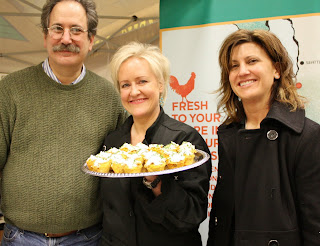I've always admired women who have been cooking for years. They glide effortlessly through the kitchen, anticipating their next move well in advance. Armed with a killer collection of recipes--tried and true, and terrific crowd pleasers, they exude a "knowingness" that only time and experience can provide.
Over time, certain recipes weave themselves into your identity. When I was growing up, our neighbor, Kay, made the best cakes. I'll never forget the Barbie cake she made when I turned five. Barbie stood proudly erect, skirted by a dome of pink and green frosting. She may have made it for me, but that was Kay's cake, and everyone knew it.
When I think of my friend Kathy, I'm instantly transported to a spot in her kitchen. Deep in conversation about the latest
New Yorker, literacy in America, or West Coast restaurant launches, we talk late into the night, buoyed by one of her famous margaritas in one hand, and a crunchy scallop fritter in the other!
And Naomi? Words cannot describe how incredible her food is. While her tamales are the stuff of legend, I've got big love for her empanadas. I leave Naomi's table with such pleasure....it's a dining experience like no other, and one that reverberates with me for days.
Now, imagine traveling around the world, collecting recipes from friends and relatives along the way. In my mind, I picture Tessa's notebook splattered, doodled in from front to back, and barely holding together. Each recipe has a story and transports you back to a particular time and place. Her book, Falling Cloudberries is exactly that, and I treasure it dearly.
My own collection of recipes includes a page from her book.

Tessa's Chickpea, Feta and Cilantro Salad makes frequent appearances both at home and for social occasions. It travels well, is easily doubled, and if there are dietary restrictions in the crowd? I've got it covered. Vegetarian? Yep. Gluten-free? Check!
Simple and yet packed with flavor, this salad has become one of my signature dishes. For an entree version, I line a platter with fresh spinach or romaine, add the chickpea salad, and top it with grilled shrimp or chicken.
Chickpea, Feta and Cilantro Salad
From Falling Cloudberries, by Tessa Kiros
1 (14-ounce) can chickpeas, drained and rinsed well
1 cup olive oil
1 large red onion, chopped
5 garlic cloves, very finely chopped
1 or 2 red chiles, seeded and finely chopped
1 2/3 cups crumbled feta cheese*
4 scallions, green part only, chopped
1/2 cup chopped fresh cilantro
1 cup chopped fresh Italian parsley
Juice of 1 lemon
Heat 3 tablespoons of the olive oil and fry the red onion gently until it is cooked through and lightly golden. Add the garlic and chile and cook for a few more seconds, until you can smell the garlic. Take care not to brown the garlic. Let cool completely.
Add the chickpeas, feta, scallion, cilantro, parsley, and lemon juice and season with pepper and a pinch more salt, if needed. Add the cooled garlic oil and the remaining olive oil and mix very well.
* Fetas can vary in their punch. I toss all the ingredients together, adding the feta last. Rarely do I use the entire amount specified here. Another tip: go easy on the salt until you know how much feta you'll be using.










 Many thanks to Charlie for sharing this recipe. As he notes, if you're new to baking, it's a great bread for beginners.
Many thanks to Charlie for sharing this recipe. As he notes, if you're new to baking, it's a great bread for beginners. Tessa's Chickpea, Feta and Cilantro Salad makes frequent appearances both at home and for social occasions. It travels well, is easily doubled, and if there are dietary restrictions in the crowd? I've got it covered. Vegetarian? Yep. Gluten-free? Check!
Tessa's Chickpea, Feta and Cilantro Salad makes frequent appearances both at home and for social occasions. It travels well, is easily doubled, and if there are dietary restrictions in the crowd? I've got it covered. Vegetarian? Yep. Gluten-free? Check! 




 Not only did I rave about sous chef John Jadamec's dish, there was some shameless recipe begging going on here!
Not only did I rave about sous chef John Jadamec's dish, there was some shameless recipe begging going on here!









